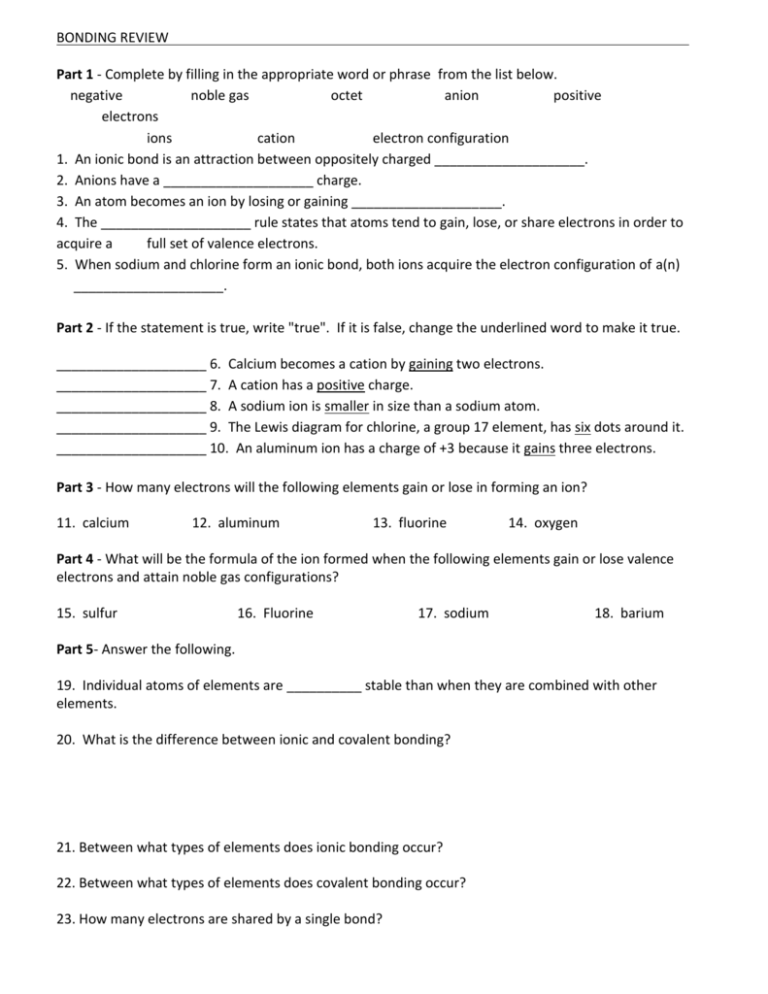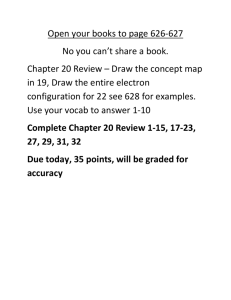Bonding Review
advertisement

BONDING REVIEW Part 1 - Complete by filling in the appropriate word or phrase from the list below. negative noble gas octet anion positive electrons ions cation electron configuration 1. An ionic bond is an attraction between oppositely charged ____________________. 2. Anions have a ____________________ charge. 3. An atom becomes an ion by losing or gaining ____________________. 4. The ____________________ rule states that atoms tend to gain, lose, or share electrons in order to acquire a full set of valence electrons. 5. When sodium and chlorine form an ionic bond, both ions acquire the electron configuration of a(n) ____________________. Part 2 - If the statement is true, write "true". If it is false, change the underlined word to make it true. ____________________ 6. Calcium becomes a cation by gaining two electrons. ____________________ 7. A cation has a positive charge. ____________________ 8. A sodium ion is smaller in size than a sodium atom. ____________________ 9. The Lewis diagram for chlorine, a group 17 element, has six dots around it. ____________________ 10. An aluminum ion has a charge of +3 because it gains three electrons. Part 3 - How many electrons will the following elements gain or lose in forming an ion? 11. calcium 12. aluminum 13. fluorine 14. oxygen Part 4 - What will be the formula of the ion formed when the following elements gain or lose valence electrons and attain noble gas configurations? 15. sulfur 16. Fluorine 17. sodium 18. barium Part 5- Answer the following. 19. Individual atoms of elements are __________ stable than when they are combined with other elements. 20. What is the difference between ionic and covalent bonding? 21. Between what types of elements does ionic bonding occur? 22. Between what types of elements does covalent bonding occur? 23. How many electrons are shared by a single bond? 24. The type of covalent bonding in which two atoms share their electrons evenly is described as _____________. 25. How many electrons are shared by a double bond? 26. The type of covalent bonding in which two atoms share electrons unevenly resulting in slightly positive and slightly negative regions of the molecule is called _______________. Ionic, Covalent, or Metallic? has an empirical formula has a molecular formula transfers electrons forms ions held together by attraction between +/- particles have high melting points have high boiling points good conductor of heat and electricity metals lose electrons and form cations non-metals gain electrons and form anions metal and non-metal combines forms "salts" form giant crystalline lattice solids formed from non-metals only share electrons held together by mutual attraction for electrons form molecules have molecular formulas have low melting points have low boiling points solid form does NOT conduct electricity formed from metals held together by sea of mobile valence electrons ductile malleable form compact arrangement and orderly crystals shiny luster water is a common example sodium chloride (table salt) is a common example sugar (glucose) is a common example compound may be S, L, or G at room temperature



